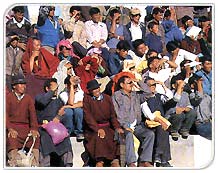Ladakh Travel Guide
---------------------------------------------------------------------------------------------------------------------------------------------------------------------------------------------------------------------------------
Ladakh Home » About Ladakh Travel Guide » Religion & Culture » Historical Background » Ancient Routes » Modern Routes
Central Ladakh » Fairs & Festivals » Oracles & Astrologers » Arts & Crafts » Cultural Tourism » Archery & Polo » Adventure in Ladakh
The New Areas » Tourist Information » Air Line Ticketing » Car Coach Rentals In Ladakh
Travel Agents & Tour Operators in Ladakh » Hotels & Resorts in Ladakh » Map »Travellers Tools
---------------------------------------------------------------------------------------------------------------------------------------------------------------------------------------------------------------------------------
Ladakh Home » About Ladakh Travel Guide » Religion & Culture » Historical Background » Ancient Routes » Modern Routes
Central Ladakh » Fairs & Festivals » Oracles & Astrologers » Arts & Crafts » Cultural Tourism » Archery & Polo » Adventure in Ladakh
The New Areas » Tourist Information » Air Line Ticketing » Car Coach Rentals In Ladakh
Travel Agents & Tour Operators in Ladakh » Hotels & Resorts in Ladakh » Map »Travellers Tools
---------------------------------------------------------------------------------------------------------------------------------------------------------------------------------------------------------------------------------
Archery & Polo
 In
Leh, and may of the villages, archery festivals are held during the summer
months, with a lot of fun and fanfare. They are competitive events, the surrounding
villages all sending teams, and the shooting takes place according to strict
etiquette, to the accompaniment of the music of surna and daman (oboe and
drum). As important as the archery are the interludes of dancing and other
entertainment. Chang, the local barley beer, flows freely, but there is rarely
any rowdiness. The crowd attend in their Sunday best, the men invariable in
traditional dress, and the women wearing their brightest brocade mantles and
their heaviest jewellery. Archery may be the pretext for the gathering, but
the party's thing.
In
Leh, and may of the villages, archery festivals are held during the summer
months, with a lot of fun and fanfare. They are competitive events, the surrounding
villages all sending teams, and the shooting takes place according to strict
etiquette, to the accompaniment of the music of surna and daman (oboe and
drum). As important as the archery are the interludes of dancing and other
entertainment. Chang, the local barley beer, flows freely, but there is rarely
any rowdiness. The crowd attend in their Sunday best, the men invariable in
traditional dress, and the women wearing their brightest brocade mantles and
their heaviest jewellery. Archery may be the pretext for the gathering, but
the party's thing. Polo is traditional to the western Himalaya, especially to Baltistan and Gilgit. It was probably introduced into Ladakh in the mid-17th century by King Sengge Namgyal, whose mother was a Balti princess. The game played here differs in many respects from the international game, which indeed, is adapted from what British travellers saw in the western Himalaya and Manipur in the 19th century. Here, each team consists of six players,a nd the game lasts for an hour with a ten minute break. Altitude notwithstanding, the hardy local ponies - the best of which come from Zanskar- scarcely seem to suffer, though play can be fast and furious. Each goal is greeted by a bust of music from surna and daman ; and the players often show extraordinary skill. For example, when starting play after a goal the scorer gallops up to midfield holding ball and mallet in the right hand, and throws the ball, hitting it in the same movement towards the opposite goal.
Unlike the international game, Polo in Ladakh is not exclusively for the rich. Traditionally, almost every village had its polo-ground, and even today it is played with verve in many places besides Leh, especially in Drass and Chushot, a big village close to Leh. In Leh, it has been partly institutionalized with regular tournaments and occasional exhibition matches being played on the polo-ground in the shadow of the palace. The local crowd takes a keen interest, especially in those matches in which a civilian team takes on the Army. Altogether, polo adds a unique kind of colour and excitement to the summer in Leh.
Ladakh Home »
About Ladakh Travel
Guide » Religion
& Culture » Historical
Background » Ancient
Routes » Modern
Routes
Central Ladakh » Fairs & Festivals » Oracles & Astrologers » Arts & Crafts » Cultural Tourism » Archery & Polo » Adventure in Ladakh
The New Areas » Tourist Information » Air Line Ticketing » Car Coach Rentals In Ladakh
Travel Agents & Tour Operators in Ladakh » Hotels & Resorts in Ladakh » Map »Travellers Tools
Central Ladakh » Fairs & Festivals » Oracles & Astrologers » Arts & Crafts » Cultural Tourism » Archery & Polo » Adventure in Ladakh
The New Areas » Tourist Information » Air Line Ticketing » Car Coach Rentals In Ladakh
Travel Agents & Tour Operators in Ladakh » Hotels & Resorts in Ladakh » Map »Travellers Tools